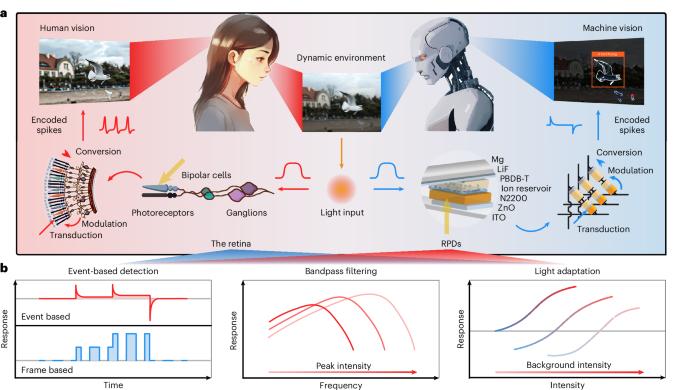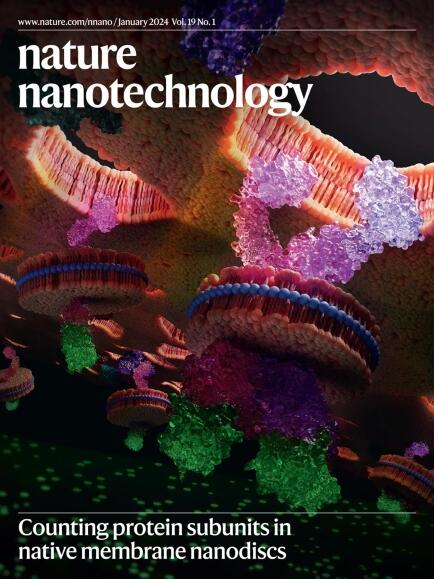具有生物似是而非的时间动态的事件驱动视胚光电二极管
IF 34.9
1区 材料科学
Q1 MATERIALS SCIENCE, MULTIDISCIPLINARY
引用次数: 0
摘要
机器视觉在工业4.0和自动驾驶中是不可或缺的,它能够实现在动态环境中导航所需的感知和反应。目前的机器视觉传感器,包括基于帧和基于事件的类型,由于其有限的时间动态与人类视网膜相比,往往不足,阻碍了它们的整体性能和适应性。在这项工作中,我们提出了一个事件驱动的视胚性光电二极管(RPD),它模拟了视网膜的分层结构和信号通路。RPD通过控制层层制造和精确的纳米结构调制,将有机供体-受体异质结、多孔网状离子储存器和肖特基结垂直集成到单个二极管中,从而实现了这一目标。每个组成部分复制了一个关键的视网膜过程,它们自发的相互作用导致了环境适应动力学。该设计产生超过200 dB的动态范围,大大降低了噪声和数据冗余,并允许高密度集成。我们证明,即使在极端照明条件下,这些改进也能实现高质量的机器视觉。我们的工作展示了一种自底向上的视网膜形态传感器方法,推动了适应复杂和动态照明环境的鲁棒和响应性机器视觉系统的发展。本文章由计算机程序翻译,如有差异,请以英文原文为准。


Event-driven retinomorphic photodiode with bio-plausible temporal dynamics
Machine vision is indispensable in Industry 4.0 and autonomous driving, enabling the perception and reaction necessary to navigate dynamic environments. Current machine vision sensors, including frame-based and event-based types, often fall short due to their limited temporal dynamics compared with the human retina, hindering their overall performance and adaptability. In this work, we present an event-driven retinomorphic photodiode (RPD) that mimics the retina’s layered structure and signal pathway. The RPD achieves this by vertically integrating an organic donor–acceptor heterojunction, an ion reservoir with a porous web-like morphology, and a Schottky junction into a single diode through controlled layer-by-layer fabrication and precise nanostructure modulation. Each component replicates a key retinal process, and their spontaneous interaction results in environment-adaptive dynamics. This design yields a dynamic range exceeding 200 dB, substantially reduces noise and data redundancy, and allows for high-density integration. We demonstrate that these improvements enable high-quality machine vision, even under extreme lighting conditions. Our work demonstrates a bottom-up approach to retinomorphic sensors, propelling the development of robust and responsive machine vision systems adaptable to complex and dynamic lighting environments. A photodiode with bio-plausible event sensing, filtering and adaptation behaviours to replicate the retinal nanostructure and visual pathway is presented, enabling consistent and high-performance machine vision under extreme lighting.
求助全文
通过发布文献求助,成功后即可免费获取论文全文。
去求助
来源期刊

Nature nanotechnology
工程技术-材料科学:综合
CiteScore
59.70
自引率
0.80%
发文量
196
审稿时长
4-8 weeks
期刊介绍:
Nature Nanotechnology is a prestigious journal that publishes high-quality papers in various areas of nanoscience and nanotechnology. The journal focuses on the design, characterization, and production of structures, devices, and systems that manipulate and control materials at atomic, molecular, and macromolecular scales. It encompasses both bottom-up and top-down approaches, as well as their combinations.
Furthermore, Nature Nanotechnology fosters the exchange of ideas among researchers from diverse disciplines such as chemistry, physics, material science, biomedical research, engineering, and more. It promotes collaboration at the forefront of this multidisciplinary field. The journal covers a wide range of topics, from fundamental research in physics, chemistry, and biology, including computational work and simulations, to the development of innovative devices and technologies for various industrial sectors such as information technology, medicine, manufacturing, high-performance materials, energy, and environmental technologies. It includes coverage of organic, inorganic, and hybrid materials.
 求助内容:
求助内容: 应助结果提醒方式:
应助结果提醒方式:


